Experimental Investigation into the Thermal Performance of Personal Cooling Mechanisms
Abstract
1. Introduction
1.1. Personal Cooling Systems
- Cooling Water Circulation Vest: This cooling vest uses cool water to dissipate body heat by the physical parameter of conduction of the cold water.
- Air cooling vest: This cooling technique uses convection and sweat evaporation due to air circulation generated by fans.
- Phase-change material cooling vest: This cooling mechanism utilises microcapsules that can change from solid to liquid to remove heat from the user’s body.
- Water evaporation vest: This vest utilises a simple cooling technique, which is the evaporation of water to reduce body heat.
- Hybrid cooling vest: This innovative vest integrates multiple cooling techniques into a single design. For instance, it may feature a combination of phase change materials (PCMs) alongside fans to enhance air circulation or blend water evaporation methods with PCMs for effective cooling.
1.2. Methods for Characterisation of Cooling Garments
- Thermophysiological prediction models: Thermophysiological comfort models can be categorised into single-node, two-node, and multi-node models, depending on how the body is divided for simulation purposes. The single-node predictive model considers the complete body, while the two-node and multi-node models break the body into different parts [20]. Fanger’s PMV (Predicted Mean Vote) model was the first classical single-node thermal comfort model [21]. This model is based on a combination of physical environmental factors and human physiological factors, establishing a linear relationship between mean skin temperature, perspiration rate, and activity intensity, but it applies only under uniform conditions. In the two-node model, which simplifies the human body into two layers, skin and core, the most used comfort model is from Gagge et al. [22]. Multi-node models include the Stolwijk model [23], which is designed only for steady-state conditions, and the Tanabe et al. [24] model, which applies to steady-state, transient, and non-uniform conditions. Several recent models have enhanced existing frameworks, such as the JOS-2 [25] and JOS-3 [26], which build upon the foundational Tanabe model. Furthermore, notable improvements have been made to the Stolwijk model, including integrating the Fiala et al. model [27,28] and the UC Berkeley Thermophysiological Comfort model [29,30]. Another thermoregulation model, THERMODE 23 (Thermoregulation Model for Disuniform Environments) [31], was recently introduced. This model thoughtfully incorporates the latest advancements in both active and passive systems, as well as advancements in the modelling of thermal sensation. The use of thermophysiological models provides quick results and allows the assessment of various combinations using estimated data to predict human thermal responses. However, a limitation of these models is that they yield simulations rather than precise measurements, and exceptions must be considered such as the type of activity, age, and race, among other parameters.
- Standard method according to ASTM F2371-24: This testing method uses a thermal manikin to evaluate the cooling power and duration of a cooling vest. It measures the heat needed to maintain the mean skin temperature of the manikin, but it does not assess thermophysiological parameters.
- Standard method according to ASTM F2300-22: This method involves conducting tests with individuals to understand their physiological responses, comfort levels, and thermal sensations while wearing the garment. Additionally, specific test methods with human subjects have been developed by individual laboratories to suit the particular use of the garment; for instance, Tokizawa et al. [32] examined a vest with a fluid circulation system, while Lai and Wu [33] tested the thermal comfort of firefighting suits with different types of vests.
1.3. Individual Thermal Comfort and Sensation
2. Materials and Methods
2.1. Methodology
2.2. Equipment
2.2.1. Thermal Manikin with Manikin PC Software
2.2.2. Climatic Chamber
2.3. Experimental Procedure
2.3.1. Testing Samples
2.3.2. Testing Protocol
- Local skin temperature (Tsk): Taken directly from each region of the manikin and calculated from the model. In this case, it was the mean skin temperature of the torso region.
- Hypothalamus temperature (Thy): The hypothalamus temperature is the most representative of cardiac and brain temperature and represents the core temperature measurement in this software. The hypothalamus is the centre of our body’s thermoregulation and controls our internal temperature, activating, for example, evaporation in case of an increase in our core temperature, so it is an essential parameter to evaluate the thermal comfort of the body.
- Thermal comfort index: According to a 7-point scale from −3 (very uncomfortable) to 3 (very comfortable) from the ISO 10551-19 standard.
- Thermal sensation index: According to the ASHRAE-55-2023 standard with a 7-point scale ranging from −3 (cold) to 3 (hot).
- Cooling vest 1: charge the battery and fill the reservoir with water.
- Cooling vest 2: charge the battery.
- Cooling vest 3: immerse in water and drain.
- Cooling vest 4: Place the PCM packs in a freezer at −50.0 °C for 40 min.
3. Results
3.1. Mean Skin Temperature of Torso Zone
3.2. Hypothalamus Temperature
3.3. Thermal Sensation Index
3.4. Thermal Comfort Index
4. Discussion
Limitations and Future Considerations
5. Conclusions
Author Contributions
Funding
Institutional Review Board Statement
Informed Consent Statement
Data Availability Statement
Acknowledgments
Conflicts of Interest
References
- Pharo Gagge, A.; Gonzalez, R.R. Mechanisms of heat exchange: Biophysics and Physiology. In Comprehensive Physiology; American Physiological Society: Bethesda, MD, USA, 2011; pp. 45–84. [Google Scholar] [CrossRef]
- Gagnon, D.; Ollie, J.; Kenny, G.P. The evaporative requirement for heat balance determines whole-body sweat rate during exercise under conditions permitting full evaporation. J. Physiol. 2013, 591, 2925–2935. [Google Scholar] [CrossRef] [PubMed]
- Li, A. Optimizing Athletic Performance and Health: Strategies for Training in Hot Environments. Stud. Sports Sci. Phys. Educ. 2024, 2, 33–37. [Google Scholar] [CrossRef]
- Stevens, K.; Fuller, M. Thermoregulation and Clothing Comfort. In Textile-Led Design for the Active Ageing Population; Woodhead Publishing Series in Textiles; Woodhead Publishing: Sawston, UK, 2015; pp. 117–138. [Google Scholar] [CrossRef]
- Pascoe, D.D.; Shanley, L.A.; Smith, E.W. Clothing and exercise: Part I. Biophysics of heat transfer between the individual, clothing, and environment. Sports Med. 1994, 18, 38–54. [Google Scholar] [CrossRef] [PubMed]
- Raymond, C.; Matthews, T.; Horton, R.M. The emergence of heat and humidity too severe for human tolerance. Sci. Adv. 2020, 6, eaaw1838. [Google Scholar] [CrossRef] [PubMed]
- Lan, L.; Wargocki, P.; Wyon, D.P.; Lian, Z. Effects of thermal discomfort in an office on perceived air quality, SBS symptoms, physiological responses, and human performance. Indoor Air 2011, 21, 376–390. [Google Scholar] [CrossRef]
- Vicedo-Cabrera, A.M.; Scovronick, N.; Sera, F.; Royé, D.; Schneider, R.; Tobias, A.; Astrom, C.; Guo, Y.; Honda, Y.; Hondula, D.M.; et al. The burden of heat-related mortality attributable to recent human-induced climate change. Nat. Clim. Change 2021, 11, 492–500. [Google Scholar] [CrossRef] [PubMed]
- Copernicus: 2024. Available online: https://climate.copernicus.eu/global-climate-highlights (accessed on 6 February 2025).
- Romanello, M.; Walawender, M.; Hsu, S.-C.; Moskeland, A.; Scamman, D.; Palmeiro-Silva, Y.; Ali, Z.; Ameli, N.; Angelova, D.; Ayeb-Karlsson, S.; et al. The 2024 report of the Lancet Countdown on health and climate change: Facing record-breaking threats from delayed action. Lancet 2024, 404, 1847–1896. [Google Scholar] [CrossRef]
- United Nations Climate Change. The Paris Agreement. Available online: https://unfccc.int/ (accessed on 20 October 2024).
- EN 342; Protective Clothing—Ensembles and Garments for Protection Against Cold. CEN-CENELEC, European Committee for Standardization: Brussels, Belgium, 2017.
- EN 14058; Protective Clothing-Garment for Protection Against Cool Environments. CEN-CENELEC, European Committee for Standardization: Brussels, Belgium, 2017.
- Bach, A.; Maley, M.; Minett, G.; Zietek, S.A.; Stewart, K.L.; Stewart, I.B. An evaluation of personal cooling systems for reducing thermal strain whilst working in chemical/biological protective clothing. Front. Physiol. 2019, 10, 424. [Google Scholar] [CrossRef]
- Jing, Y.; Du, M.; Zhang, P.; Liang, Z.; Du, Y.; Yao, L.; Chen, H.; Zhang, T.; Zhang, K. Advanced cooling textile technologies for personal thermoregulation. Mater. Today Phys. 2024, 41, 101334. [Google Scholar] [CrossRef]
- Nishihara, N.; Tanabe, S.; Hayama, H.; Komatsu, M. A cooling vest for working comfortably in a moderately hot environment. J. Physiol. Anthr. Appl. Hum. Sci. 2002, 21, 75–82. [Google Scholar] [CrossRef]
- Ciuha, U.; Valenčič, T.; Mekjavic, I.B. Cooling efficiency of vests with different cooling concepts over 8-hour trials. Ergonomics 2021, 64, 625–639. [Google Scholar] [CrossRef] [PubMed]
- ASTM F2371; Standard Test Method for Measuring the Heat Removal Rate of Personal Cooling Systems Using a Sweating Heated Manikin. ASTM International: West Conshohocken, PA, USA, 2024.
- ASTM F2300; Standard Test Method for Measuring the Performance of Personal Cooling Systems Using Physiological Testing. ASTM International: West Conshohocken, PA, USA, 2022.
- Islam, M.; Golovin, K.; Dolez, P. Clothing Thermophysiologal Comfort: A Textile Science Perspective. Textiles 2023, 3, 353–409. [Google Scholar] [CrossRef]
- Fanger, P. Thermal Comfort Analysis and Applications in Environmental Engineering; Copenhagen Danish Technical Press: Copenhagen, Denmark, 1970. [Google Scholar]
- Gagge, A.; Stolwijk, J.; Nishi, Y. An effective temperature scale based on a simple model of human physiological regulatory response. ASHRAE Trans. 1971, 77, 247–262. [Google Scholar]
- Stolwijk, J. Mathematical Model of Thermoregulation. Physiol. Behav. Temp. Regul. 1970, 48, 721. [Google Scholar]
- Tanabe, S.; Kobayashi, K.; Nakano, J.; Ozeki, Y. Evaluation of thermal comfort model using combined multi-node thermoregulation (65MN) and radiation models and computational fluid dynamics (CFD). Energy Build. 2002, 34, 637–646. [Google Scholar] [CrossRef]
- Takahashi, Y.; Nomoto, A.; Yoda, S.; Hisayama, R.; Ogata, M.; Ozeki, Y.; Tanabe, S. Thermoregulation model JOS-3 with new open-source code. Energy Build. 2021, 231, 110575. [Google Scholar] [CrossRef]
- Koelblen, B.; Psikuta, A.; Bogdan, A.; Annaheim, S.; Rossi, R.M. Thermal sensation models: A systematic comparison. Indoor Air 2017, 27, 680–689. [Google Scholar] [CrossRef]
- Fiala, D.; Lomas, K.J.; Stohrer, M. A computer model of human thermoregulation for a wide range of environmental conditions: The passive system. J. Appl. Physiol. 1999, 87, 1957–1972. [Google Scholar] [CrossRef]
- Fiala, D.; Lomas, K.J.; Stohrer, M. Computer prediction of human thermoregulatory and temperature responses to a wide range of environmental conditions. Int. J. Biometeorol. 2001, 45, 143–159. [Google Scholar] [CrossRef]
- Huizenga, C.; Hui, Z.; Arens, E. A model of human physiology and comfort for assessing complex thermal environments. Build. Environ. 2001, 36, 691–699. [Google Scholar] [CrossRef]
- Zhang, C.H.; Huizenga, E.; Arens, T.Y. Considering individual physiological differences in a human thermal model. J. Therm. Biol. 2001, 26, 401–408. [Google Scholar] [CrossRef]
- D’Ambrossio Alfano, F.R.; Palella, B.I.; Riccio, G. THERMODE 2023: Formulation and Validation of a new Thermo-physiological Model for Moderate Environments. Build. Environ. 2024, 252, 111272. [Google Scholar] [CrossRef]
- Tokizawa, K.; Son, S.; Oka, T.; Yasuda, A. Effectiveness of a field-type liquid cooling vest for reducing heat strain while wearing protective clothing. Ind. Health 2020, 58, 63–71. [Google Scholar] [CrossRef] [PubMed]
- Lai, W.; Wu, C. Verification of comfort-enhanced liquid cooling vest. Appl. Sci. 2021, 11, 10799. [Google Scholar] [CrossRef]
- Lian, Z. Revisiting thermal comfort and thermal sensation. Build. Simul. 2024, 17, 185–188. [Google Scholar] [CrossRef]
- ISO 10551-19; Ergonomics of the Physical Environment—Subjective Judgement Scales for Assessing Physical Environments. International Standard Organization: Geneva, Switzerland, 2019.
- ANSI/ASHRAE 55; Thermal Environmental Conditions for Human Occupancy. American Society of Heating Refrigerating and Air Conditioning Engineers (ASHRAE): Peachtree Corners, GA, USA, 2023.
- ISO 7730; Ergonomics of the Thermal Environment—Analytical Determination and Interpretation of Thermal Comfort Using Calculation of the PMV and PPD Indices and Local Thermal Comfort Criteria. International Standard Organization: Geneva, Switzerland, 2005.
- Thermetrics: Advanced Thermal Measurement Technology. Available online: https://thermetrics.com/ (accessed on 25 October 2024).
- ISO 15831; Clothing—Physiological Effects—Measurement of Thermal Insulation by Means of a Thermal Manikin. Standard Organization: Geneva, Switzerland, 2004.
- ASTM F2370; Standard Test Method for Measuring the Evaporative Resistance of Clothing Using a Sweating Manikin. ASTM International: West Conshohocken, PA, USA, 2024.
- Thermoanalytics Inc. Available online: https://www.thermoanalytics.com/ (accessed on 2 October 2024).
- Psikuta, A.; Weibel, M.; Burke, R.; Hepokoski, M.; Schwenn, T.; Annaheim, S.; Rossi, R.M. A Systematic Approach to the Development and Validation of Adaptive Manikins. Extrem. Physiol. Med. 2015, 4, A15. [Google Scholar] [CrossRef]
- Psikuta, A. Development of an “Artificial Human” for Clothing Research; De Montfort University: Leicester, UK, 2009. [Google Scholar]
- Burke, R.; Blood, K.; Deaton, A.S.; Barker, R. Application of Model-Controlled Manikin to Predict Human Physiological Response in Firefighter Turnout Gear Paper Presentation. In Proceedings of the Eighth International Meeting for Manikins and Modelling, Victoria, BC, Canada, 22–26 August 2010. [Google Scholar]
- Albert, M.M.; García, P.D.; Belda, E.B. Development of a new testing protocol to evaluate cooling systems. EXCLI J. 2023, 22, 583–594. [Google Scholar] [CrossRef]
- ISO 8996; Ergonomics of the Thermal Environment—Determination of Metabolic Rate. International Standard Organization: Geneva, Switzerland, 2021.
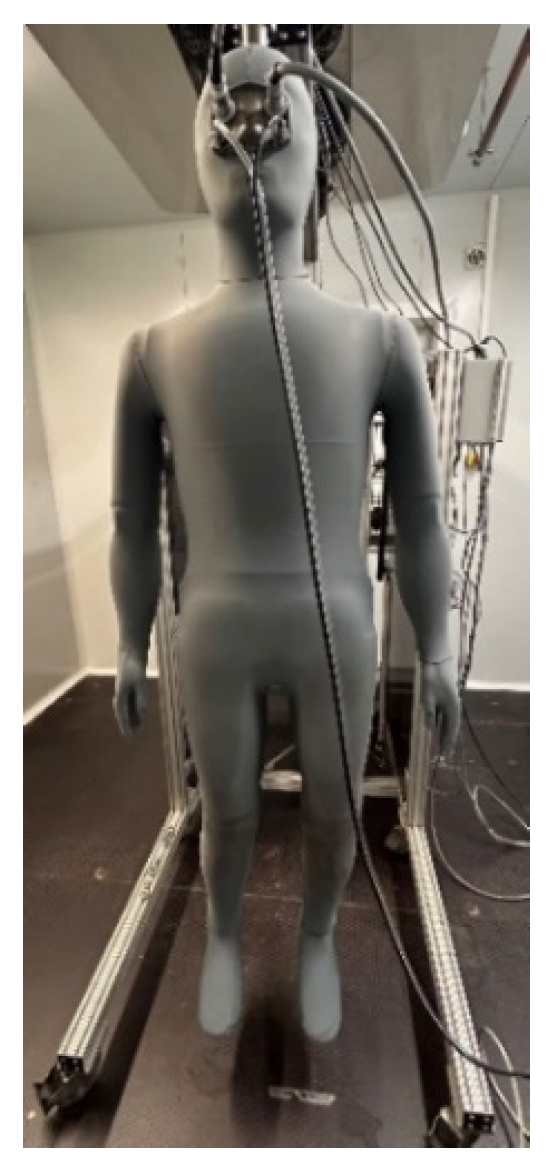
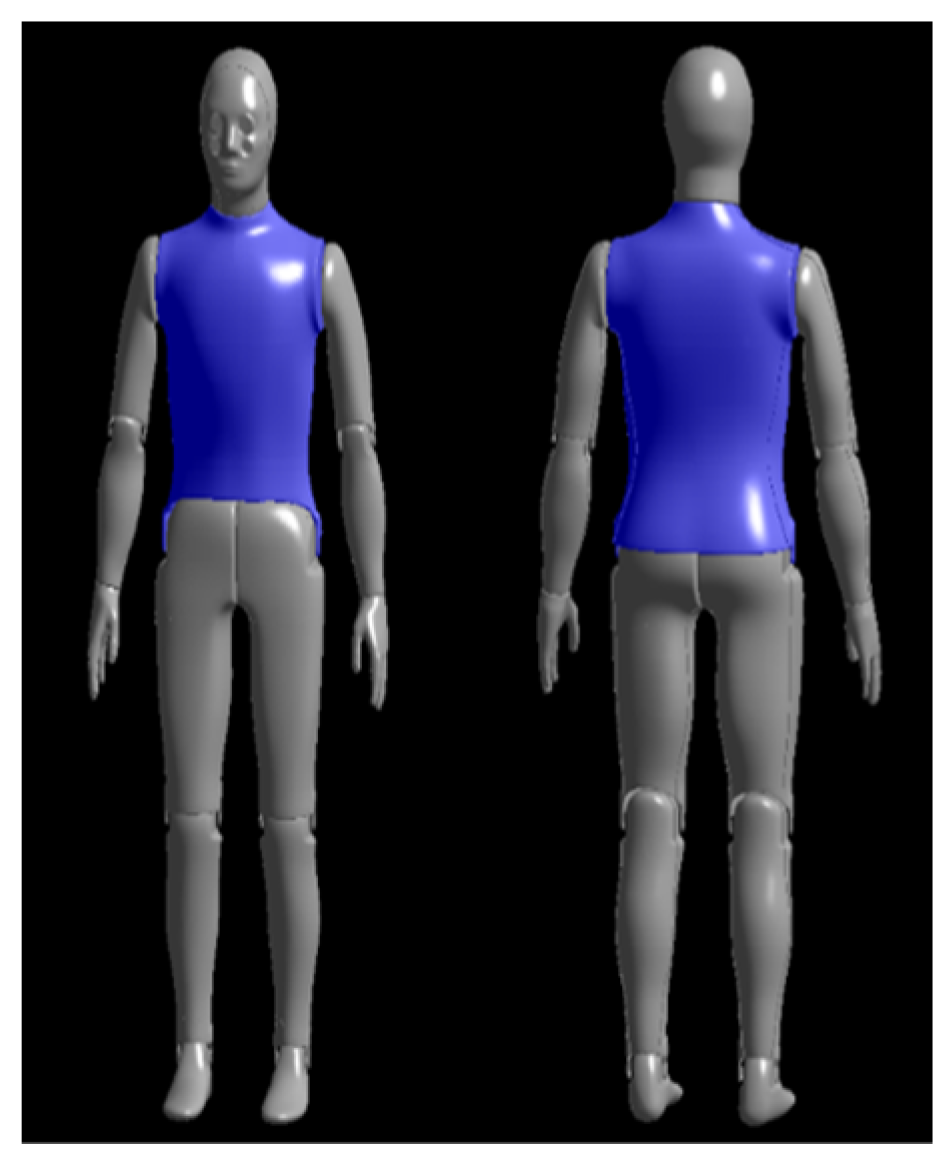
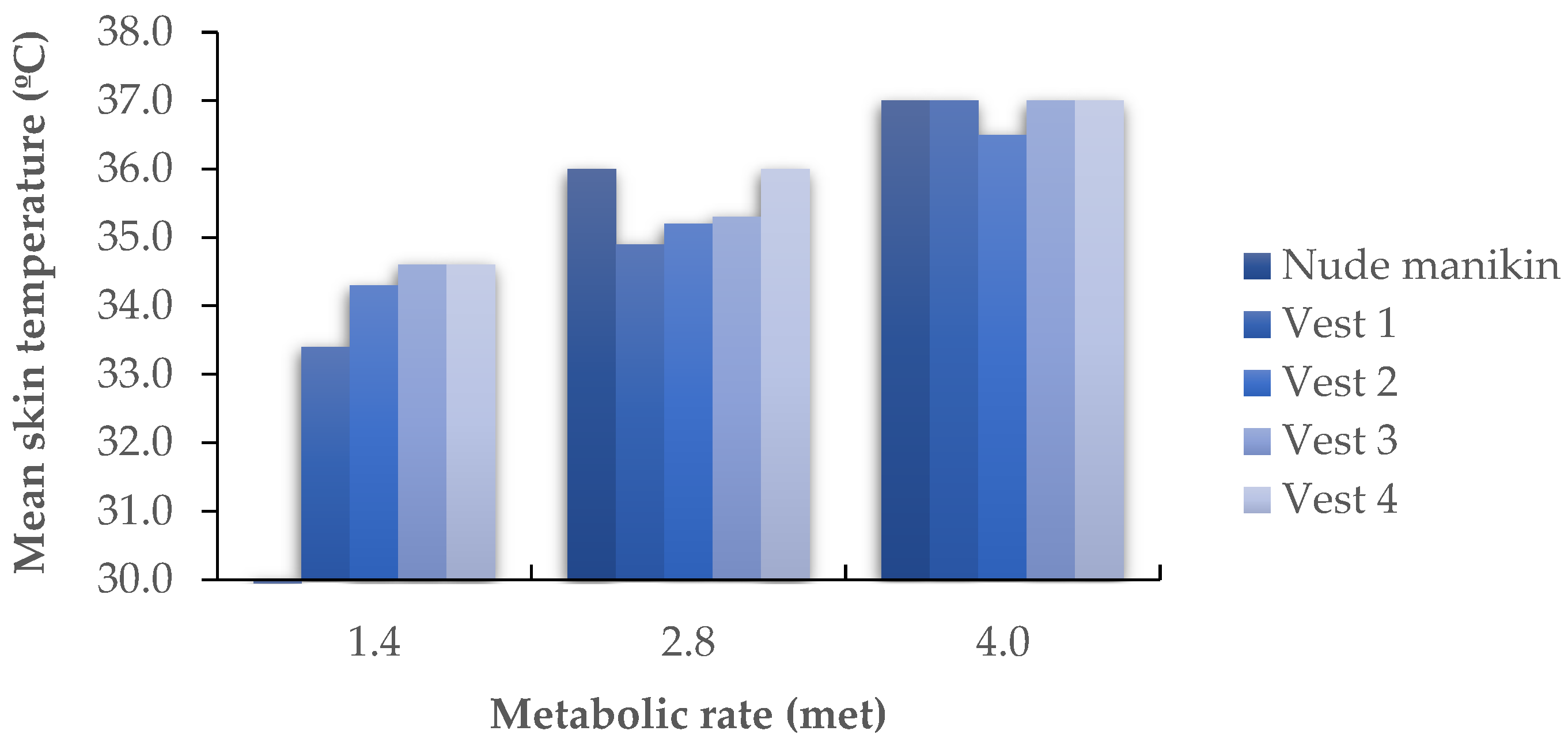
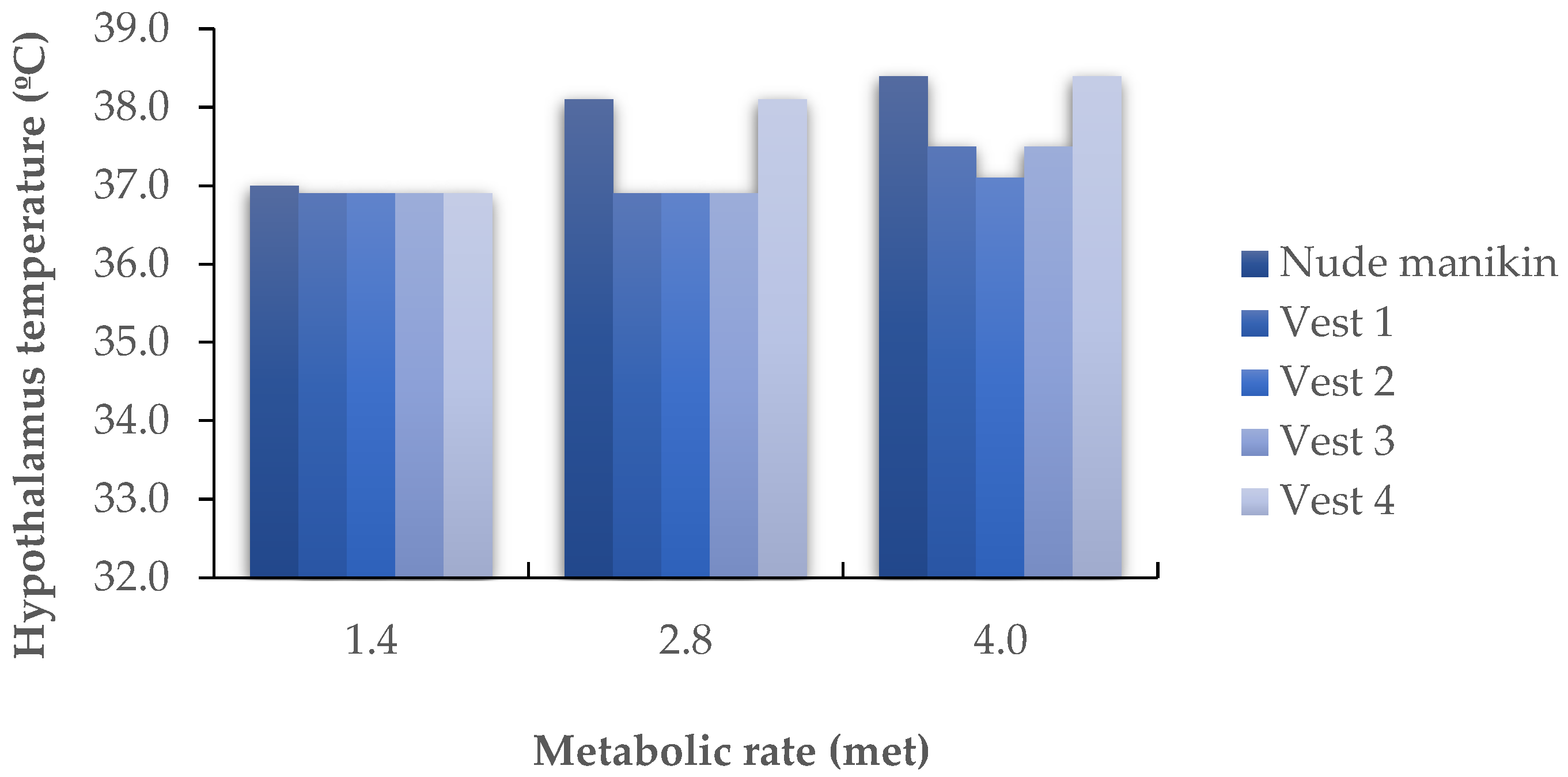
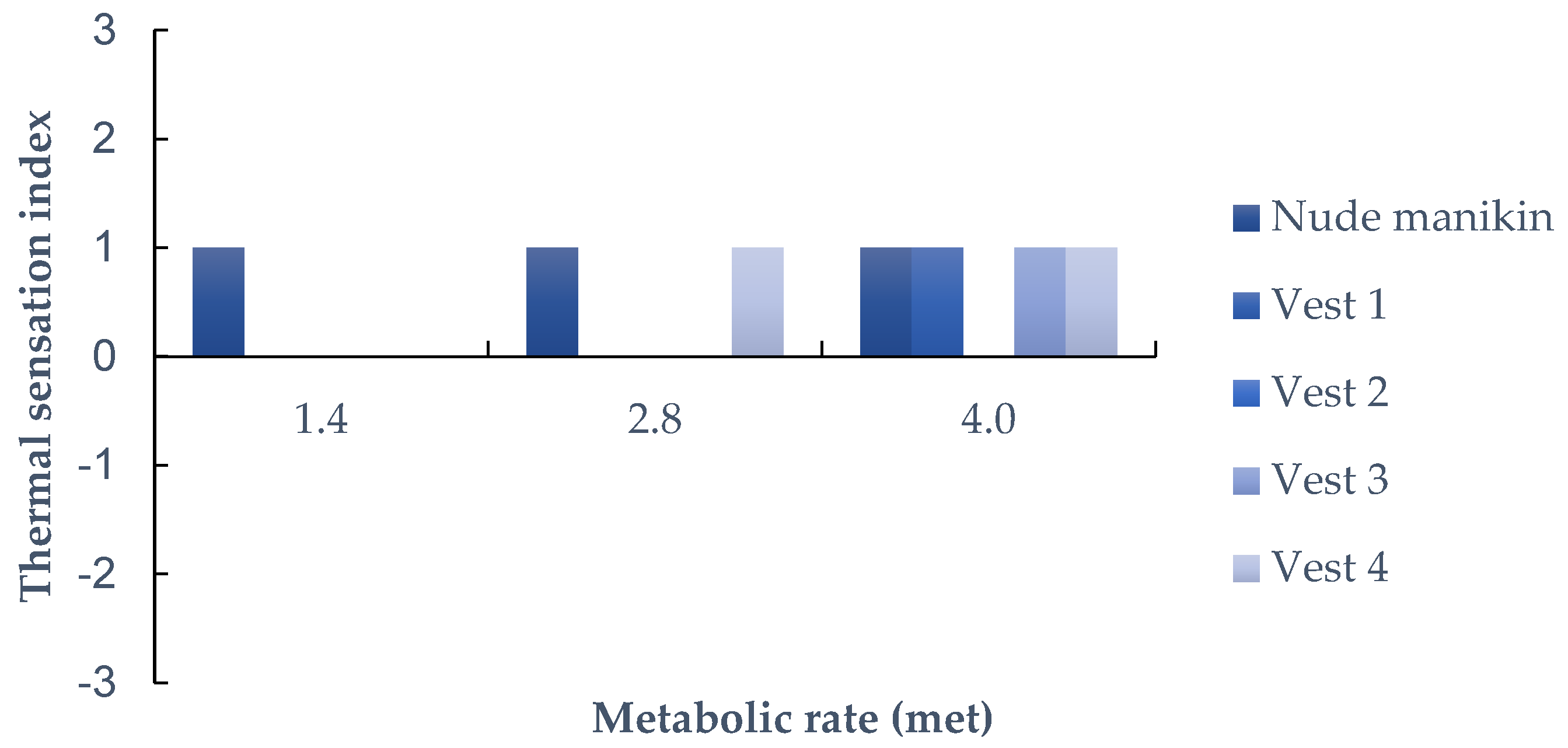
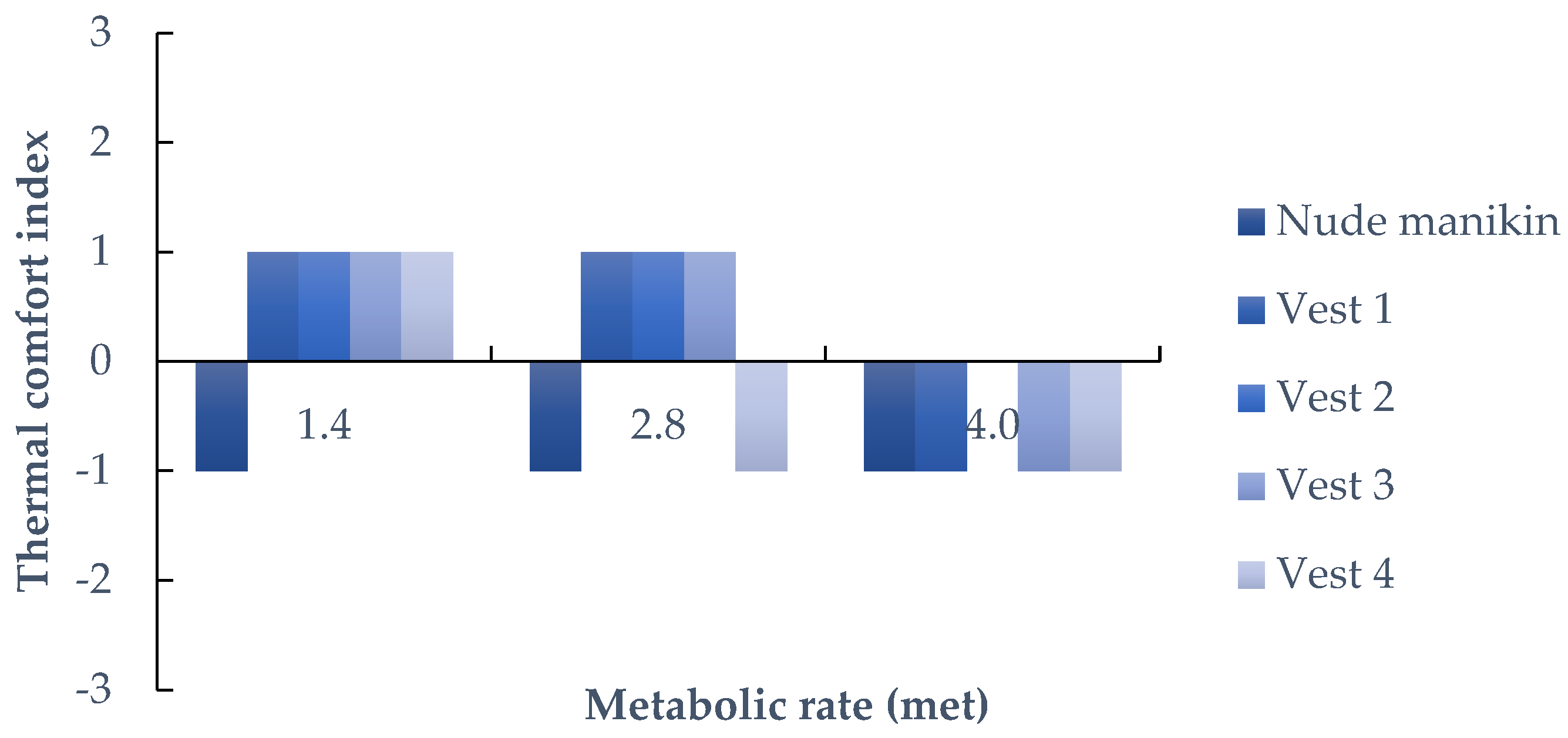
| Level | Thermal Comfort |
|---|---|
| −3 | Very uncomfortable |
| −2 | Uncomfortable |
| −1 | Slightly uncomfortable |
| 0 | Neutral |
| 1 | Slightly comfortable |
| 2 | Comfortable |
| 3 | Very comfortable |
| Level | Thermal Sensation |
|---|---|
| −3 | Cold |
| −2 | Cool |
| −1 | Slightly cool |
| 0 | Neutral |
| 1 | Slightly warm |
| 2 | Warm |
| 3 | Hot |
| Cooling Vest | Cooling Mechanism | Accessories |
|---|---|---|
| 1 | Cooling water circulation | Pump, cooling system, battery |
| 2 | Air circulation | Battery |
| 3 | Water evaporation | --- |
| 4 | PCMs (28 °C) | PCM packs |
| Activity Level | Range of Metabolic Rate (W) | Range of Metabolic Rate (W/m2) | Range of Metabolic Rate (met) |
|---|---|---|---|
| Resting | 100–125 | 55–69 | 1.0–1.2 |
| Low metabolic rate | 125–235 | 69–130 | 1.2–2.2 |
| Moderate metabolic rate | 235–360 | 130–200 | 2.2–3.4 |
| High metabolic rate | 360–465 | 250–258 | 3.4–4.4 |
| Samples Tested | Mean Skin Temperature TSk (°C ± 0.1 °C) | ||
|---|---|---|---|
| 1.4 met | 2.8 met | 4.0 met | |
| Nude manikin | 35.3 | 36.0 | 37.0 |
| Vest 1 | 33.4 | 34.9 | 37.0 |
| Vest 2 | 34.3 | 35.2 | 36.5 |
| Vest 3 | 34.6 | 35.3 | 37.0 |
| Vest 4 | 34.6 | 36.0 | 37.0 |
| Samples Tested | Hypothalamus Temperature Thy (°C ± 0.1 °C) | ||
|---|---|---|---|
| 1.4 met | 2.8 met | 4.0 met | |
| Nude manikin | 37.0 | 38.1 | 38.4 |
| Vest 1 | 36.9 | 36.9 | 37.5 |
| Vest 2 | 36.9 | 36.9 | 37.1 |
| Vest 3 | 36.9 | 36.9 | 37.5 |
| Vest 4 | 36.9 | 38.1 | 38.4 |
| Samples Tested | Thermal Sensation Index | ||
|---|---|---|---|
| 1.4 met | 2.8 met | 4.0 met | |
| Nude manikin | 1 | 1 | 1 |
| Vest 1 | 0 | 0 | 1 |
| Vest 2 | 0 | 0 | 0 |
| Vest 3 | 0 | 0 | 1 |
| Vest 4 | 0 | 1 | 1 |
| Samples Tested | Thermal Comfort Index | ||
|---|---|---|---|
| 1.4 met | 2.8 met | 4.0 met | |
| Nude manikin | −1 | −1 | −1 |
| Vest 1 | 1 | 1 | −1 |
| Vest 2 | 1 | 1 | 0 |
| Vest 3 | 1 | 1 | −1 |
| Vest 4 | 1 | −1 | −1 |
Disclaimer/Publisher’s Note: The statements, opinions and data contained in all publications are solely those of the individual author(s) and contributor(s) and not of MDPI and/or the editor(s). MDPI and/or the editor(s) disclaim responsibility for any injury to people or property resulting from any ideas, methods, instructions or products referred to in the content. |
© 2025 by the authors. Licensee MDPI, Basel, Switzerland. This article is an open access article distributed under the terms and conditions of the Creative Commons Attribution (CC BY) license (https://creativecommons.org/licenses/by/4.0/).
Share and Cite
Martinez-Albert, M.; Díaz-García, P.; Montava-Seguí, I.; Bou-Belda, E. Experimental Investigation into the Thermal Performance of Personal Cooling Mechanisms. Appl. Sci. 2025, 15, 3296. https://doi.org/10.3390/app15063296
Martinez-Albert M, Díaz-García P, Montava-Seguí I, Bou-Belda E. Experimental Investigation into the Thermal Performance of Personal Cooling Mechanisms. Applied Sciences. 2025; 15(6):3296. https://doi.org/10.3390/app15063296
Chicago/Turabian StyleMartinez-Albert, Miriam, Pablo Díaz-García, Ignacio Montava-Seguí, and Eva Bou-Belda. 2025. "Experimental Investigation into the Thermal Performance of Personal Cooling Mechanisms" Applied Sciences 15, no. 6: 3296. https://doi.org/10.3390/app15063296
APA StyleMartinez-Albert, M., Díaz-García, P., Montava-Seguí, I., & Bou-Belda, E. (2025). Experimental Investigation into the Thermal Performance of Personal Cooling Mechanisms. Applied Sciences, 15(6), 3296. https://doi.org/10.3390/app15063296







